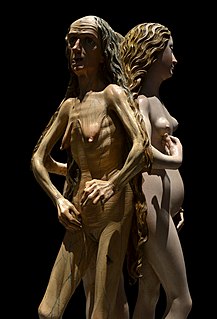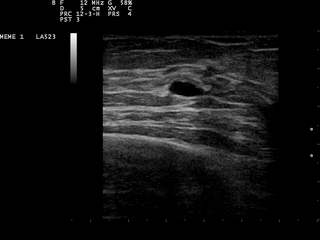 W
WAdipomastia, also known colloquially as fatty breasts, is a condition defined as an excess of skin and adipose tissue in the breasts without true breast glandular tissue. It is commonly present in men with obesity, and is particularly apparent in men who have undergone massive weight loss. A related/synonymous term is pseudogynecomastia. The condition is different and should be distinguished from gynecomastia, which involves true glandular breast development in a male. The two conditions can usually be distinguished easily by palpation to check for the presence of glandular tissue. Another difference between the conditions is that breast pain/tenderness does not occur in pseudogynecomastia. Sometimes, gynecomastia and pseudogynecomastia are present together; this is related to the fact that fat tissue expresses aromatase, the enzyme responsible for the synthesis of estrogen, and estrogen is produced to a disproportionate extent in men with excessive amounts of fat, resulting in simultaneous glandular enlargement.
 W
WBreast atrophy is the normal or spontaneous atrophy or shrinkage of the breasts.
 W
WA breast cyst is a fluid-filled sac within the breast. One breast can have one or more breast cysts. They are often described as round or oval lumps with distinct edges. In texture, a breast cyst usually feels like a soft grape or a water-filled balloon, but sometimes a breast cyst feels firm.
 W
WBreast engorgement occurs in the mammary glands due to expansion and pressure exerted by the synthesis and storage of breast milk. It is also a main factor in altering the ability of the infant to latch-on. Engorgement changes the shape and curvature of the nipple region by making the breast inflexible, flat, hard, and swollen. The nipples on an engorged breast are flat or inverted. Sometimes it may lead to striae on nipples, mainly a preceding symptom of septation mastitis.
 W
WBreast hypertrophy is a rare medical condition of the breast connective tissues in which the breasts become excessively large. The condition is often divided based on the severity into two types, macromastia and gigantomastia. Hypertrophy of the breast tissues may be caused by increased histologic sensitivity to certain hormones such as female sex hormones, prolactin, and growth factors. Breast hypertrophy is a benign progressive enlargement, which can occur in both breasts (bilateral) or only in one breast (unilateral). It was first scientifically described in 1648.
 W
WA breast mass, also known as a breast lump, is a localized swelling that feel different from the surrounding tissue. Breast pain, nipple discharge, or skin changes may be present. Concerning findings include masses that are hard, do not move easily, are of an irregular shape, or are firmly attached to surrounding tissue.
 W
WA cyst of Montgomery is a benign breast mass, usually found in adolescent girls. Typically, it resolves spontaneously by itself.
 W
WDuct ectasia of the breast, mammary duct ectasia or plasma cell mastitis is a condition in which occurs when a milk duct beneath the nipple widens, the duct walls thicken and the duct fills with fluid. This is the most common cause of greenish discharge. Mammary duct ectasia can mimic breast cancer. It is a disorder of peri- or post-menopausal age.
 W
WFibroadenomas are benign breast tumours characterized by an admixture of stromal and epithelial tissue. Breasts are made of lobules and ducts. These are surrounded by glandular, fibrous and fatty tissues. Fibroadenomas develop from the lobules. The glandular tissue and ducts grow over the lobule to form a solid lump.
 W
WFibrocystic breast changes is a condition of the breasts where there may be pain, breast cysts, and breast masses. The breasts may be described as "lumpy" or "doughy". Symptoms may worsen during certain parts of the menstrual cycle. It is not associated with cancer.
 W
WGalactorrhea or lactorrhea is the spontaneous flow of milk from the breast, unassociated with childbirth or nursing.
 W
WGynecomastia is an endocrine system disorder in which a noncancerous increase in the size of male breast tissue occurs. Psychological distress or dysphoria may occur.
 W
WAn inverted nipple is a condition where the nipple, instead of pointing outward, is retracted into the breast. In some cases, the nipple will be temporarily protruded if stimulated. Both women and men can have inverted nipples.
 W
WFissure of the nipple, colloquially referred to as "jogger's nipple", is a condition that is the result of irritation of one or both nipples as the result of chafing, the friction of clothing against the nipple during physical exercise. The issue is commonly seen in athletes, such as runners or surfers who do not wear rash guards.
 W
WLatch refers to how the baby fastens onto the breast while breastfeeding. A good latch promotes high milk flow and minimizes nipple discomfort for the mother, whereas poor latch results in poor milk transfer to the baby and can quickly lead to sore and cracked nipples. In a good latch, both the nipple and a large portion of the areola are in the baby's mouth.
 W
WMammary myofibroblastoma (MMFB) is a rare, benign tumor of the breast.
 W
WMammoplasia is the normal or spontaneous enlargement of human breasts. Mammoplasia occurs normally during puberty and pregnancy in women, as well as during certain periods of the menstrual cycle. When it occurs in males, it is called gynecomastia and is considered to be pathological. When it occurs in females and is extremely excessive, it is called macromastia and is similarly considered to be pathological. Mammoplasia may be due to breast engorgement, which is temporary enlargement of the breasts caused by the production and storage of breast milk in association with lactation and/or galactorrhea. Mastodynia frequently co-occurs with mammoplasia.
 W
WMastitis is inflammation of the breast or udder, usually associated with breastfeeding. Symptoms typically include local pain and redness. There is often an associated fever and general soreness. Onset is typically fairly rapid and usually occurs within the first few months of delivery. Complications can include abscess formation.
 W
WMondor's disease is a rare condition which involves thrombophlebitis of the superficial veins of the breast and anterior chest wall. It sometimes occurs in the arm or penis. In axilla, this condition is known as axillary web syndrome.
 W
WNipple discharge is any fluid that leaks from the nipple of one or both breasts, either with or without squeezing the breast. The discharge can be milky, clear, green, bloody, brown or straw-colored. The consistency can be thick, thin, sticky or watery.
 W
WPseudoangiomatous stromal hyperplasia (PASH), is an overgrowth of myofibroblastic cells in the breast. It has an appearance similar to fibroadenomatoid changes.
 W
WPtosis or sagging of the female breast is a natural consequence of aging. The rate at which a woman's breasts drop and the degree of ptosis depends on many factors. The key factors influencing breast ptosis over a woman's lifetime are cigarette smoking, her number of pregnancies, gravity, higher body mass index, larger bra cup size, and significant weight change. Post-menopausal women or people with collagen deficiencies may experience increased ptosis due to a loss of skin elasticity. Many women and medical professionals mistakenly believe that breastfeeding increases sagging. It is also commonly believed that the breast itself offers insufficient support and that wearing a bra prevents sagging, which has not been found to be true.
 W
WTuberous breasts are a result of a congenital abnormality of the breasts which can occur in both men and women, one breast or both. During puberty breast development is stymied and the breasts fail to develop normally and fully. The exact cause of this is as yet unclear; however, a study in 2011 of the cells in the breasts of both males and females with tubular breasts suggested a genetic link in a disorder of collagen deposition. The condition is thought to affect one to five per cent of breast augmentation patients; however, the proportion of the general population affected is unknown as surgery is not always sought.